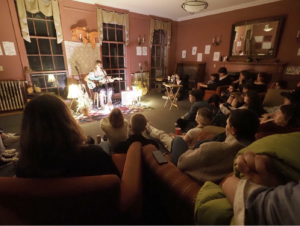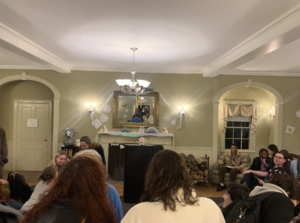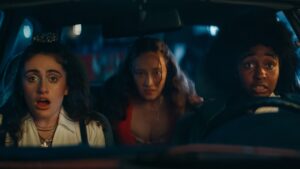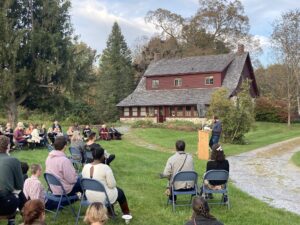This exhibit was curated by Mark Christman with curatorial research from Jake Meginsky, and designed for the Usdan Gallery by Anne Thompson. The exhibit was first displayed in Philadelphia in 2020, and has since visited New York and Los Angeles as well before coming to Bennington College.
The Usdan Gallery is on the 2nd floor of VAPA and hosts several exhibitions from senior art shows to works from contemporary artists. For the opening, there was a small stage area on the first floor for the performance by the music faculty.
The exhibition was packed. Guests had to squeeze through groups of people to get from one artwork to another. The first thing you are welcomed with as you enter the gallery is a beautiful hand-painted drumset and a large television screen mounted on the wall with a video of Graves playing.
There are four sections of the large rectangular gallery representing Graves’ interests. The first section, to the left of the entrance, is dedicated to Yara, his own martial arts form based on the movements of praying mantises. This section contains a display of black and white photographs of Graves and others practicing the art. There is an entire binder full of these photos along with some bigger prints of people showing off their moves. Next to the photo display, there are four small TVs on pedestals, each displaying videos of Graves demonstrating the martial art by himself or sparring with others.
The next section covers Graves’ prolific music career as a free jazz drummer starting in the mid-60s and beyond. There are two vitrines full of album covers, magazine articles, posters, and other ephemera from his career. There are vinyls from collaborations with other artists. Guests are also invited to listen to two of his performances, one from his basement in the 90s and another from a more recent performance on stage.
Around 7pm, the whole room was shaken with the sound of a loud gong. Everyone turned to see Bennington faculty Michael Wimberly brandishing the gong as he hit it again to make sure he got everyone’s attention. He led the large crowd downstairs to view the marked off stage area where the band was ready to play. He took his place at the drumset and the music began, accompanied by Bennington faculty Senem Pirler, faculty emeritus Bruce Willaimson, and instructor Michael Bisio. They played improvisational jazz that could be heard from inside the exhibition. The ground floor and the stairs were packed with people, so I took this opportunity to get a closer look at the rest of the exhibition.
The next section is about Graves’ exploration of the human heart and its rhythms. On the wall behind a vitrine displaying various heart-related ephemera, there are two TV screens showing diagrams and pictures related to Graves’ heart-related research. The exhibit label names them ‘LabView Animations’. LabView is a visual programming language and development environment. A giant LabView chart hangs on a nearby wall, showing a bigger, better example of what it can create. Above the vitrine there is a sound shower that envelops the viewer in the sounds of the demonstrational record of heartbeat that inspired Graves’ research with rhythm.
This area also includes a series of multimedia sculptures put together by Graves. These sculptures contain materials from a human skeleton to a plasma globe. There are many of these multimedia sculptures around the exhibit: a punching bag hung from the ceiling next to the Yara photos, a video of an ultrasound of a heart. All of these sculptures were created from ready-made objects from his house and laboratory, including medical models of a spine, a head, and acupuncture models.
The last section is a selection of full color photographs of Graves’ house in Jamaica, Queens. The house is itself a work of art, with ornamentation inspired by Graves’ travels decorating the inside and outside. The house had many purposes, such as a dojo for his martial arts and a laboratory for investigating the heart. The basement was also used as a studio for his drumming. Along with the photographs, there is a wooden chair with extensive decoration akin to the house. The house is also where he made these sculptures and held his extensive “global garden”.
Along with the opening reception, there will be three other events related to the exhibition. On Friday, March 1st at 8pm, Jason Moran has a solo performance in the Deane Carriage Barn titled “After Milford”. On Wednesday, March 13th at 8pm there will be a performance by saxophonist William Parker and pianist Cooper-Moore also in the Deane Carriage barn. Lastly, on Monday the 18th at 7pm in Tishman Auditorium there will be a screening of the documentary Milford Graves Full Mantis (2018) which will be followed by a discussion with the director, Jake Meginsky who graduated from Bennington in 2009.
The exhibit is up until April 27th. The gallery will be open Tuesdays to Saturdays 1-5 pm. On the dates of the previously mentioned events, the gallery will be open late, until 7:30pm.






Be First to Comment